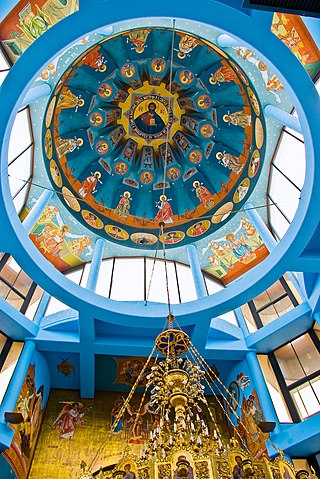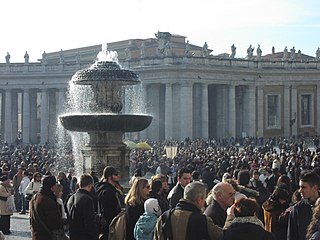The Roman Curia comprises the administrative institutions of the Holy See and the central body through which the affairs of the Roman Catholic Church are conducted. The Roman Curia is the institution which the Roman Pontiff ordinarily makes use of in the exercise of his supreme pastoral office and universal mission in the world. It is at the service of the Pope, successor of Peter, and of the Bishops, successors of the Apostles, according to the modalities that are proper to the nature of each one, fulfilling their function with an evangelical spirit, working for the good and at the service of communion, unity and edification of the Universal Church and attending to the demands of the world in which the Church is called to fulfill its mission.

The Society of Saint Pius X is an international fraternity of traditionalist Catholic priests founded in 1970 by Archbishop Marcel Lefebvre, not a leading traditionalist voice at the Second Vatican Council but turned years later after voting in favor of the documents of Vatican II, the Coetus Internationalis Patrum, and Superior General of the Holy Ghost Fathers until 1968. The society was initially established as a pious union of the Catholic Church with the permission of François Charrière, the Bishop of Lausanne, Geneva and Fribourg in Switzerland. In 2022, the society reached over 700 priestly members, with 1,135 total members.

Humanum genus is a papal encyclical promulgated on 20 April 1884 by Pope Leo XIII.
Mystici Corporis Christi is a papal encyclical issued by Pope Pius XII on 29 June 1943 during World War II. Its main topic is the Catholic Church as the Mystical Body of Christ.

Consecrated life is a state of life in the Catholic Church lived by those faithful who are called to follow Jesus Christ in a more exacting way. It includes those in institutes of consecrated life, societies of apostolic life, as well as those living as hermits or consecrated virgins/widows.
Subsistit in is a Latin phrase which appears in Lumen gentium, the document on the church from the Second Vatican Council of the Catholic Church. Since the council, the reason for use of the term "subsists in" rather than simply "is" has been disputed. Generally, those who see little or no change in church teaching in Vatican II insist on the equivalence of subsistit in and "is". Those who point to a new, ecumenical thrust in Vatican II insist that the term was introduced as a compromise after much discussion, and acknowledges new elements in the council's teaching.
In the Catholic Church, a secular institute is one of the forms of consecrated life recognized in Church law.
A secular institute is an institute of consecrated life in which the Christian faithful living in the world strive for the perfection of charity and work for the sanctification of the world, especially from within.
In the Catholic Church, an association of the Christian faithful or simply association of the faithful sometimes called a public association of the faithful, is a group of baptized persons, clerics or laity or both together, who, according to the 1983 Code of Canon Law, jointly foster a more perfect life or promote public worship or Christian teaching, or who devote themselves to other works of the apostolate.
Orientales ecclesias is an encyclical of Pope Pius XII concerning the persecution of the Eastern Catholic Churches and describing the desperate situation of the faithful in Bulgaria.
Pope Pius XII and Russia describes relations of the Vatican with the Soviet Union, Russia, the Eastern Orthodox Church, and the Eastern Catholic Churches resulting in the eradication of the Church in most parts of the Soviet Union during the Stalinist era. Most persecutions of the Church occurred during the pontificate of Pope Pius XII.

Eastern Catholic victims of Soviet persecutions include bishops and others among the tens of thousands of victims of Soviet persecutions from 1918 to approximately 1980, under the state ideology of Marxist–Leninist atheism.

The 1983 Code of Canon Law, also called the Johanno-Pauline Code, is the "fundamental body of ecclesiastical laws for the Latin Church". It is the second and current comprehensive codification of canonical legislation for the Latin Church of the Catholic Church. It was promulgated on 25 January 1983 by John Paul II and took legal effect on the First Sunday of Advent 1983. It replaced the 1917 Code of Canon Law which had been promulgated by Benedict XV on 27 May 1917.

Precedence signifies the right to enjoy a prerogative of honor before other persons; for example, to have the most distinguished place in a procession, a ceremony, or an assembly, to have the right to express an opinion, cast a vote, or append a signature before others, to perform the most honorable offices.
The canonical situation of the Society of Saint Pius X (SSPX), a group founded in 1970 by Archbishop Marcel Lefebvre, is unresolved.

Catholic laity are the ordinary members of the Catholic Church who are neither clergy nor recipients of Holy Orders or vowed to life in a religious order or congregation. Their mission, according to the Second Vatican Council, is to "sanctify the world".
Provida Mater Ecclesia was an apostolic constitution by Pope Pius XII, that recognized secular institutes as a new form of official consecration in the Catholic Church.
Primo Feliciter was a motu proprio issued by Pope Pius XII on March 12, 1948.
Cum Sanctissimus was an instruction issued on March 19, 1948, by the Sacred Congregation for Religious and Secular Institutes of the Catholic Church. The instruction clarified specific issues with respect to the approving religious institutes.
The Eastern Catholic canon law is the law of the 23 Catholic sui juris (autonomous) particular churches of the Eastern Catholic tradition. Eastern Catholic canon law includes both the common tradition among all Eastern Catholic Churches, now chiefly contained in the Code of Canons of the Eastern Churches, as well as the particular law proper to each individual sui juris particular Eastern Catholic Church. Oriental canon law is distinguished from Latin canon law, which developed along a separate line in the remnants of the Western Roman Empire, and is now chiefly codified in the 1983 Code of Canon Law.
Doroteo Hernández Vera was a Spanish Roman Catholic priest and the founder of the secular institute Cruzada Evangélica. He served as a chaplain following his ordination and celebrated clandestine Masses and other services during the Spanish Civil War leading to his arrest. It was during his imprisonment that he saw the need to better evangelize to bring the Gospel message to those that either rejected or did not know about God while also seeing it as his objective to minister in prisons. He did this in the time after his release from prison until near the end of his life when he retired upon the significant decline of his health.







